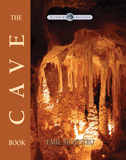Crystal Rate of Growth Debated
Tall tales about tall crystals
News Source
- ACS: “Slower than a Snail’s Pace”
The largest known gypsum crystals in the world are in the Naica Mexico mine’s Cave of Crystals. Discovered in April 2000, the crystals in the cave are up to 35 feet long and 3 feet in diameter. A study published in the 20 September 2011 Proceedings of the National Academy of Sciences asserts that these crystals required nearly a million years to grow.
The extreme clarity and uniformity of these beautiful crystals indicate that the conditions under which they formed remained quite stable. In fact, occasional changes in conditions are indicated by a few visible inclusions of other minerals.1 The crystal-containing limestone caves in this complex are all situated near faults.2
Geologists suspect that geothermal forces pushed mineral-rich water into the caves.
Geologists suspect that geothermal forces pushed mineral-rich water into the caves. Sulfuric acid formed by oxidation of sulfide minerals likely reacted with the limestone to produce calcium sulfate, which crystallizes as gypsum. But what determines the mechanism and speed at which such huge crystals can form?
Crystals form in supersaturated solutions as ionic compounds equilibrate between their soluble and solid forms. Any change in conditions can alter the rate at which crystals form. Alterations in temperature, pressure, ionic concentrations, salinity or acidity of the cave water, and any number of other conditions could disrupt the orderly growth of these crystals or change the rate at which they grow. The growth patterns of these crystals suggest they grew under stable conditions.
The researchers in the present study have measured the incredibly slow rates of growth possible in “the current Naica waters”3 at various temperatures. “This is the slowest growth rate ever measured, not only in nature but in general,” said study author Juan Manuel García-Ruiz.4 From this measurement they calculate the large crystals required about 990,000 years to form. Actually, however, the water in which these crystals were growing was drained in 1975.5 So the researchers are assuming that cave water from another place and time contains exactly the same milieu as that which birthed these crystals.6
As the researchers state in their study, assuming the mechanism they suggest for crystal growth is correct, a one-meter diameter crystal “formed at 55 degrees Celsius from a solution with the same composition as current Naica waters, should have been growing for 0.99 +/- 0.27 million years. The same crystal growing at 56 degrees Celsius should have formed over the course of half a million years.”7 The researchers consider temperature to be the only possible variable.
Yet even if we accepted the possibility of a million-year-timescale (which we do not, as it totally violates the eyewitness chronology from God’s Word), it would be difficult to believe all the chemical components of mineral-rich water supplied by geothermal conditions near a fault remained perfectly stable for nearly a million years. Therefore, another crystal growth mechanism or another set of conditions—which would necessarily result in a different rate of crystal growth—should tell a shorter tale of these tall crystals.
However these magnificent crystals formed, they formed within the few thousand years since the Flood. And given the stability of conditions needed to form them, the true time frame is likely many orders of magnitude smaller than that proposed in the latest study. How long is that? Likely closer to the 30 or so years originally suggested by the mining company geologist and superintendent of exploration in a Mexican newspaper article.8
The researchers point out that their method of dating these crystals seems “awkward” compared to “absolute dating techniques”9 like radiometric dating. But those radiometric dates in which they would put complete faith are impossible to obtain due to the lack of uranium in the gypsum. Yet the method they have chosen requires precise knowledge of past conditions which cannot be known in the present. We should put no faith in either.
Further Reading
For More Information: Get Answers
Remember, if you see a news story that might merit some attention, let us know about it! (Note: if the story originates from the Associated Press, FOX News, MSNBC, the New York Times, or another major national media outlet, we will most likely have already heard about it.) And thanks to all of our readers who have submitted great news tips to us. If you didn’t catch all the latest News to Know, why not take a look to see what you’ve missed?
(Please note that links will take you directly to the source. Answers in Genesis is not responsible for content on the websites to which we refer. For more information, please see our Privacy Policy.)
Footnotes
- Juan Manuel García-Ruiz et al., “Formation of Natural Gypsum Megacrystals in Naica, Mexico,” Geology 35, no. 4 (April 2007): 327–330, doi:10.1130/G23393A.1.
- Ibid.
- A. E. S. Van Driessche et al., “Ultraslow Growth Rates of Giant Gypsum Crystals,” PNAS 108, no. 38 (September 20, 2011): 15721–15726, doi:10.1073/pnas.1105233108.
- “Crystals Break Slow Growth Record,” Discovery News, September 13, 2011, http://news.discovery.com/earth/naica-mine-crystals-growth-110913.html.
- Ibid.
- The closest thing to fluid samples from the water in which the crystals originally grew is that which is trapped in “fluid inclusions.” The investigators said in their 2007 Geology study that these inclusions are “very scarce.” They estimated the temperature at which the crystals originally formed from the chemical concentrations in a small number of these fluid inclusions and hope in the future to be able to test a larger sample of them. (The average of these values was 54-58 degrees Celsius, but calculations actually ranged from below 40 degrees to above 60 degrees. Only at 55 degrees would the predicted growth rate under current conditions be one million years. One degree warmer drops that to half a million. No prediction is suggested for the other possible temperatures, and, even at that, the only estimates possible are for “current Naica water.” The original Naica water is long gone.) However, there is evidently not enough even of this trapped fluid remaining to directly measure the crystal growth in it.
- Van Driessche et al., “Ultraslow Growth Rates of Giant Gypsum Crystals.”
- “Giant Selenite Crystals,” MineralTown.com, http://www.mineraltown.com/Reports/giant_crystals/giant_selenite_crystals.php.
- Van Driessche et al., “Ultraslow Growth Rates of Giant Gypsum Crystals.”
Recommended Resources

Answers in Genesis is an apologetics ministry, dedicated to helping Christians defend their faith and proclaim the good news of Jesus Christ.
- Customer Service 800.778.3390
- Available Monday–Friday | 9 AM–5 PM ET
- © 2025 Answers in Genesis






